自考英语词汇学 第九章完整ppt课件
- 格式:ppt
- 大小:178.50 KB
- 文档页数:25
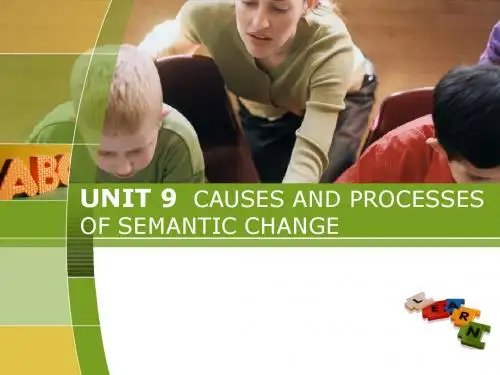
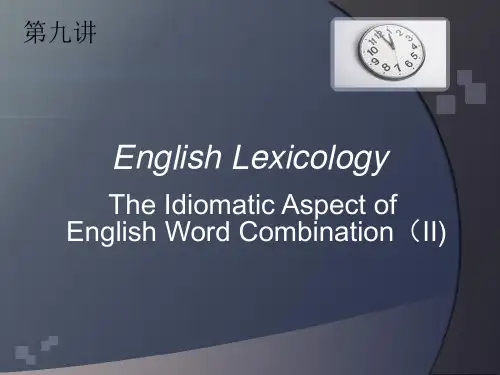
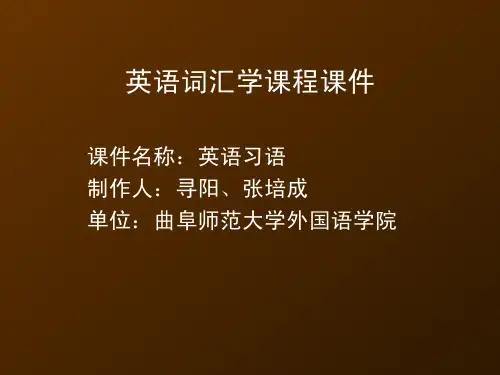
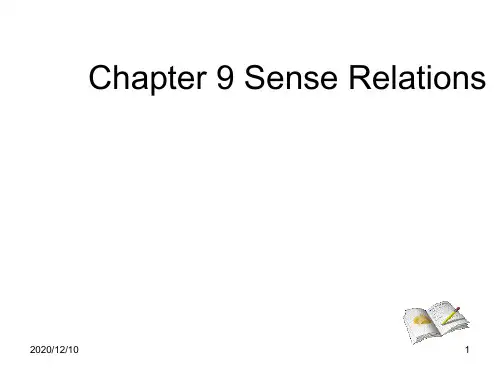
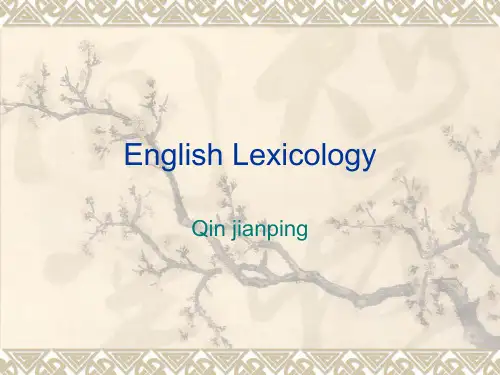
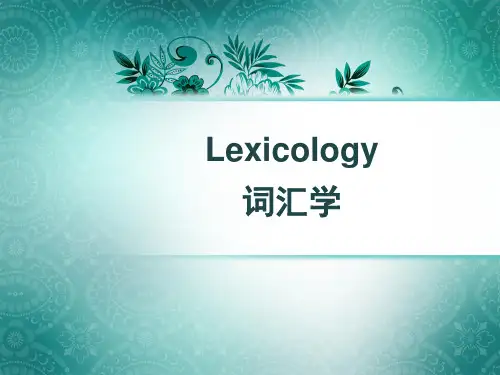

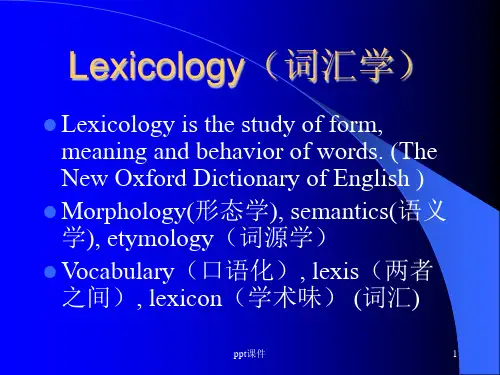
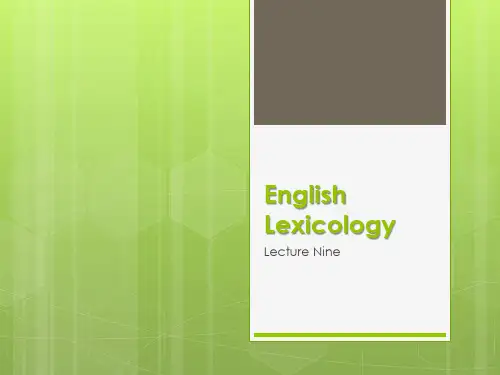

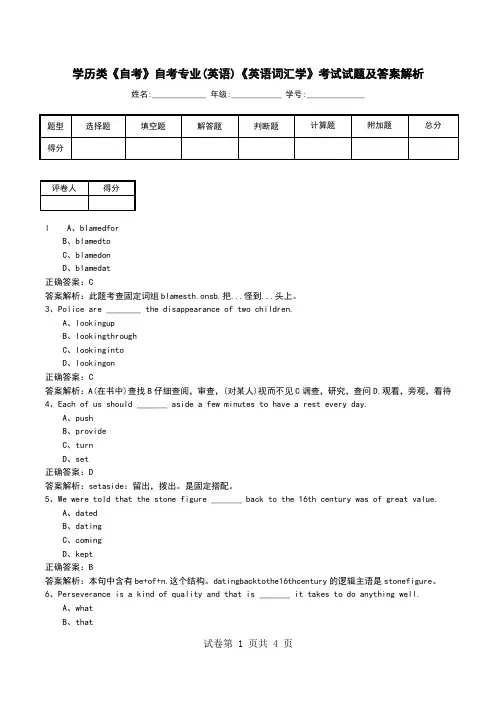
学历类《自考》自考专业(英语)《英语词汇学》考试试题及答案解析姓名:_____________ 年级:____________ 学号:______________l A、blamedforB、blamedtoC、blamedonD、blamedat正确答案:C答案解析:此题考查固定词组blamesth.onsb.把...怪到...头上。
3、Police are ________ the disappearance of two children.A、lookingupB、lookingthroughC、lookingintoD、lookingon正确答案:C答案解析:A(在书中)查找B仔细查阅,审查,(对某人)视而不见C调查,研究,查问D.观看,旁观,看待4、Each of us should _______ aside a few minutes to have a rest every day.A、pushB、provideC、turnD、set正确答案:D答案解析:setaside:留出,拨出。
是固定搭配。
5、We were told that the stone figure _______ back to the 16th century was of great value.A、datedB、datingC、comingD、kept正确答案:B答案解析:本句中含有be+of+n.这个结构。
datingbacktothe16thcentury的逻辑主语是stonefigure。
6、Perseverance is a kind of quality and that is _______ it takes to do anything well.A、whatB、thatC、whichD、why正确答案:A答案解析:what在表语从句中作takes的宾语,构成”Ittakessth.todosth.”的句型。
自考《英语词汇学》复习资料自考《英语词汇学》复习资料第一章1. Word —— A word is a minimal free form of a language that has a given sound and meaning and syntactic function.2. There is no logical relationship between sound and meaning as the symbolic connection between them is arbitrary and conventional. E.g. ―woman‖ means ’Frau’ in German,’Femme’ in French and ’Funv ’in Chinese. On the other hand,the same sound /rait/ can mean right,rite and write,though denoting different things,yet have the same sound.3. The difference between sound and form result from 4 major factors.(At least 80%of the English words fit consistent spelling patterns)a). the internal reason is English alphabet does not have a separate letter to represent each sound in the language.b). Pronunciation has changed more rapidly than spelling c). Influence of the work of scribes/printing freezes the spelling of words in 1500 d). Borrowing of foreign language4. Vocabulary ——Vocabulary is most commonly used to refer to the sum total of all the words of a language. It can also refer to all the words of a given dialect,a given book,a given subject and all the words possessed by an individual person as well as all the words current in a particular period of time in history.The general estimate of the present day English vocabulary is over 1 million words.5.Classification of Words—by use frequency,by notion,byorigin1). Basic word stock – the foundation of the vocabulary.1. all national character (most important)–natural phenomenamost common things and phenomena of the human body and relationsworld around us names of plants and animalsaction,size,domain,statenumerals,pronouns,prep. ,conj.2. stability – they donate the commonest thing necessary to life,they are like to remain unchanged. Only relative,some are undergoing some changes. But the change is slow.e.g. arrow,bow,chariot,knight – pastelectricity,machine,car,plane —— now3. productivity – they are mostly root words or monosyllabic words,they can form new words with other roots and affixes.e.g. foot – football,footage,footpath,footer4. polysemy –often possess more than one meaning. Become polysemous.e.g. take to move or carry from one place to anotherto remove5. collocability –quite a number of set expressions,idiomatic usages,proverbial saying and otherse.g. heart – a change of heart, a heart of goldNon-basic vocabulary ——1. terminology – technical termsphotoscanning,hepatitis,indigestion,penicillin,algebra,trigonometry,calculus2. jargon – specialized vocabulary in certain professions.Bottom line,ballpark figures,bargaining chips,hold himback,hold him in,paranoid3. slang ——substandard words often used in informal occasionsdough and bread,grass and pot,beaver,smoky,bear,catch,holler,Roger,X-rays,Certain words are labeled slang because of their usage.4. argot – words used by sub-cultured groupscan-opener,dip,persuadercant,jargon ,argot are associated with,or most available to,specific groups of the population.5. dialectal words – only by speakers of the dialectbeauty,chook,cocky,station,auld,build,coo,hame,lough,bog6. archaisms – words no longer in common use or restricted in use. In older poems,legal document and religious writing or speech.7. neologism – newly created words with new meaning e.g. microelectronics,futurology,AIDS,internet,E-mail old meaning acquired new meaning e.g. mouse,monitor2). Content word (notional word)– denote clear notions.Functional word (empty word,form word)– do not have notions of their own,express the relation between notions,words and sentences.a. Content words constitute the main body of the English vocabulary are numerous.Functional words are in a small number.b. Content words are growing.Functional words remain stable.c. Functional words do far more work of expression than content words.3). Native words – are words brought to Britain in the 15 century by the German tribes. Ango-Saxon Words,50,000-60,000What is true of the basic word stock is also true of native world. More are1. neutral in style (not stylistical specific )2. 2.frequent in use (in academic fields and science French,Latin or Greek are used)(usage 70-90%)Borrowed words (loan words,borrowing)–words taken over from foreign language. 80%According to the degree of assimilation and manner of borrowing,we can bring the loan words under 4 classes.1.Denizens –words borrowed early and now are well assimilated into English language.e.g. port from portus(L)shift,change,shirt,porkcup from cuppa(L)2.Aliens – retained their original pronunciation and spellinge.g. décor(F)blitzkreeg(G)emir,intermez,rowtow,bazaar,rajar,status quo3.translation loans – formed from the existing material in the English language but modeled on the patterns taken from another language.1). Word translated according to the meaninge.g. mother tough from lingua maternal(L)black humor from humor noirlong time no see,surplus value,master piece2). Words translated according to the sounde.g. kulak from kyrak(Russ)lama from lama(Tib)ketchuptea4. Semantic loans –their meaning are borrowed from another languagee.g. stupid old dumpnew sassydream old joy and peacepioneer old explorer/person doing pioneering worknew a member of the young pioneerfresh old impertinent,sassy,cheeky。